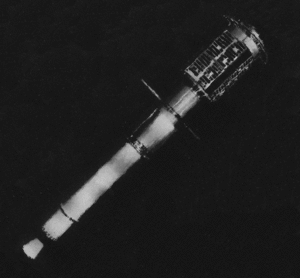Explorer 11
| Explorer 11 | |
|---|---|

|
|
| Country: |
|
| Operator: |
|
| COSPAR-ID : | 1961-013A |
| Mission dates | |
| Dimensions: | 37.2 kg |
| Begin: | April 27, 1961, 14:10 UTC |
| Starting place: | Cape Canaveral , LC-26B |
| Launcher: | Juno II |
| Flight duration: | 7 month |
| Orbit data | |
| Rotation time : | 108 min |
| Orbit inclination : | 28.89 ° |
| Apogee height : | 1786 km |
| Perigee height : | 486 km |
| Eccentricity : | .086447 |
Explorer 11 (also referred to as S 15) was a US satellite that was successfully launched on April 27, 1961 as part of the Explorer program .
begin
The 37.2 kg satellite was launched on April 27, 1961 at 2:10 p.m. UTC with a Juno II rocket from the LC-26 B launch pad at Cape Canaveral Air Force Station .
mission
The aim of the mission was to study gamma rays . For this purpose, the satellite was not only aimed at the earth's atmosphere. The sun and the galactic center should also be examined.
A Phoswich-Cerenkov quartz detector was used as an instrument for measuring the gamma radiation. It was the first device of its kind ever to be used in space. It was developed by William L. Kraushaar at MIT .
Since the satellite could not be aligned correctly, it was set in a rotation in order to be able to at least partially cover the planned areas. In addition, it was brought into a higher orbit than originally planned. Radiation from the Van Allen belt interfering with the detector and a fault in the recording device on board meant that only 141 hours of the transmitted data were usable.
